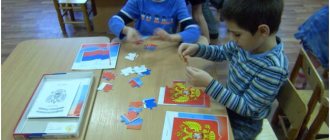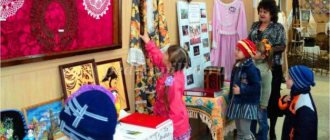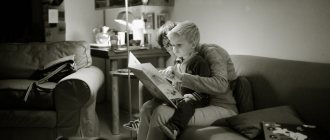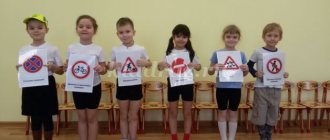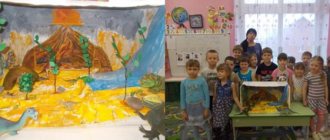Strengthening and protecting health from the first days of a child’s life is the task of every parent. And, as soon as the baby grows up and begins to attend kindergarten, teachers partially take on this task. The duty of any preschool institution is to take care of the physical and psychological well-being of pupils. Protecting children's health in preschool educational institutions
involves regular implementation of hardening, developmental and preventive measures. In addition, special attention is paid to building and maintaining a rational daily routine, quality nutrition and physical activity for each child.
Strengthening the health of children in preschool educational institutions
impossible without a range of physical exercises. Morning exercises, developmental activities, games and competitions, exercises for the prevention and correction of poor posture and flat feet, walks, exercises using sports equipment in the fresh air, etc. These activities strengthen the musculoskeletal system, improve blood circulation and breathing, help normalize digestion and metabolism, and strengthen the immune system, especially during periods of high risk of illness.
Methods for improving the health of children in preschool educational institutions also focus on the development of positive emotions in pupils. Physical education and sports activities do not aim to hone the technique of performing exercises. They are aimed at developing interest in sports and physical activity, promoting the emergence of positive emotions and strengthening children’s contact with teachers, teaching children to feel their body and move freely.
Finally, maintaining health in a preschool educational institution is impossible without hardening procedures. Hardening techniques change throughout the year, depending on weather conditions and the situation with the spread of seasonal diseases (flu, ARVI, etc.). Also, the type of hardening procedure and its intensity may vary from student to student. An individual approach is important here, taking into account the health status of each child, the characteristics of his character, physique and immunity. In order for hardening not to harm, but to bring benefit, all these parameters must be taken into account.
Next, we will consider the different types of health activities and their features.
Physical education classes
Health improvement of a child in a preschool educational institution
necessarily includes physical exercise. These or other types of exercises are selected by the physical work teacher, taking into account the age of the children.
Thus, in younger groups, the main goal of classes is to teach children to navigate in space and work with simple sports equipment and equipment. In middle groups, classes are more focused on the development of physical qualities - strength, endurance, agility. In older children, they instill the need for active movement, teach independence, organization and group work.
Any physical activity should, first of all, bring joy to the child. Therefore, the correct methods for improving the health of children in kindergarten are always varied. These are not only traditional gymnastic and sports exercises, but also outdoor games of varying intensity, rhythmic exercises, competitions and relay races, story-based exercises and much more.
“Children’s health improvement in kindergarten”
MBOU Kikinskaya MOSH of the municipal formation "Temkinsky district" of the Smolensk region.
Consultation for parents on the topic: “Children’s health improvement in kindergarten”
teacher Resnyanskaya V.V.
Explanatory note
The concept of “health” has many definitions. But the most popular and, perhaps, the most comprehensive definition is the one given by the World Health Organization: “Health is a state of complete physical, mental and social well-being, and not just the absence of disease or physical defects” (E. Torokhova)
During preschool childhood, the foundations of health, comprehensive motor readiness and harmonious physical development are laid in a child.
In recent decades, not only in Russia, but throughout the world, there has been a tendency towards deterioration in the health of the child population. Environmental problems, various negative household factors, chemical additives in food, poor-quality water, accumulating irritations in society associated with an unsatisfactory economic situation are just some of the factors that aggressively affect the health of a preschooler.
The morbidity of children observed by educators, which tends to increase, as well as the use by teachers of activities associated with the child being in a static position for a long time, led us to search for new forms and methods of health-improving work in preschool educational institutions.
One of the main tasks of a preschool organization is to create conditions that guarantee the formation and strengthening of the health of pupils.
The main means of achieving this task is the formation of a culture of healthy lifestyle. It is in order to preserve and improve the health of a child in one of the most crucial periods of his life that systematic, purposeful work is necessary, both in a preschool institution and in the family.
To achieve this goal positively, I have set the following tasks:
:
- Creating conditions for the beneficial physical development of children;
- Promote the health of children through a system of health-improving activities;
- To increase children's interest in a healthy lifestyle through various forms and methods of physical education and health activities;
- Satisfying children's natural need for movement;
- Formation of a reasonable attitude towards your health;
- Activation of cognitive interests;
- Increase the pedagogical competence of parents on the issue of preserving and strengthening the health of the child;
- Development of the child’s individuality (not programming, but promoting personality development).
- Provide a sense of psychological security and the child’s trust in the world; joys of existence (mental health);
In the groups, conditions have been created for organizing the motor activity of children, both organized and independent, and also corresponding to the age and individual characteristics of the children.
Building a health-saving space is unthinkable without implementing such an important principle of an individually differentiated approach to children.
The motor center has selected such aids, attributes, and equipment parts that meet the hygiene requirements and rules for protecting the life and health of children. One of the ways to increase children's mobility in independent activities is through various ways of using the plot in design and aids. We use story-based outdoor games with masks - hats. Play, as the leading type of activity for children, remains a priority for us in the survey of the organization of the motor environment.
The equipment is designed to develop different movements of different muscle groups.
Often (after active physical activity and before a walk) we use minutes of rest
:
- let's sit in silence;
— let’s lie on our backs and relax, as if we were rag dolls;
- let's dream to this beautiful music (relaxation).
In our work we use elements of hardening and corrective gymnastics.
The subject-spatial developmental environment in the group is organized taking into account the requirements of the Federal State Educational Standard, ensures maximum realization of the educational potential of the group space and materials, equipment and supplies for the development of preschool children, protection and promotion of their health, taking into account the characteristics and correction of deficiencies in their development. We divided the group space into separate subspaces; they represent a variety of different developmental environments in the same group room. children, what can be done in them, they are created with the purpose of presenting to each child - to give the opportunity to concentrate on their activities, experience an emotional state and serve as the basis for the implementation of program material. The layout and equipment in our group changes periodically throughout the year, following changes in the individual interests of the children and the level of development of each child. We consider the organization of the premises as a very important means of teaching education, which is effective only when it exactly corresponds to the characteristics of the children and their interests at the moment.
All toys and materials available in the group are at the disposal of the children. Any child can independently decide what materials, when and how to use to implement their own ideas and plans. Children in the group are comfortable and interesting.
Children are given the opportunity to act independently (fantasize, experiment, create), look for the extraordinary in the ordinary, study and understand the world around them through a variety of activities.
Children’s independent use of toys and materials also determines the appropriate level of responsibility for their use and storage; Children learn to be masters of their own materials and equipment: put them away and treat them with care.
The group room has privacy corners. Each child can find his own “personal” corner (his favorite place), his own territory in the group.
Our children should be healthy, and for this we don’t need much: systematic execution, habit, pleasure in doing the exercises.
The healing powers of nature are of great importance for the health of children:
- Regular walks in the fresh air;
- Sun and air baths;
- Water procedures;
- Phytotherapy;
- Vitamin therapy;
- Hardening
A child of preschool age must be outside for at least four hours every day. And in our work with children, we try to be in the fresh air as much as possible.
We know that hygiene products promote health and stimulate the development of adaptive properties of the body, therefore in our work we pay attention to:
- Personal hygiene (using artistic words);
- Ventilation;
- Wet cleaning;
- Diet;
- Proper hand washing;
- Teaching children basic healthy lifestyle techniques;
- Rinsing the mouth after eating;
- Limit the level of study load to avoid fatigue.
When creating a subject-spatial environment, we take into account that the impact on the child lies in the demand for children's experience acquired in the process of educational activities.
In educational activities, we give concepts about the use of water and air by humans, teach rules, skills to live and take care of the environment, and about your health.
In the conversations “Why do we brush our teeth”, “Food hygiene” - children become familiar with the culture of behavior and personal hygiene. We introduce children to the medicinal plants of their immediate environment. They saw them many times near the house, yard, city, but had no knowledge about them, did not know their benefits for humans. And now they recognize chamomile, dandelion, and nettle very well and tell how they can be treated with these plants. Medicinal plants help a person overcome the disease; they also treat animals and birds. We designed the album “The World Around Us” and collected a herbarium.
We tell children about the benefits of indoor plants and teach them how to care for them. We explain to them that plants suppress the activity of dangerous microorganisms that increase the bactericidal energy of the air, plants purify the air, and we know that fresh air improves health and cures many diseases. Children will learn which plants provide a healing effect - ficus, geranium, chlorophytum.
Of course, without working together with parents, we would not have achieved good results. At parent meetings and individual consultations, we teach how to assess a child’s health; we offer parents files of various gymnastics and home exercises; we recommend literature and brochures.
Accordingly, we provide recommendations and advice for parents in the “Health Corner”:
- We offer sliding folders;
- We recommend going on hikes and excursions with your children;
- We conduct a survey.
All these techniques allow us to gradually stabilize and introduce children to a healthy lifestyle. Parents and we now have one goal - to raise the health of children.
The created conditions allowed us to ensure children’s physical activity and organize recreational work in the group.
The subject-spatial environment contributes to:
- Enrichment of social experience and acquisition of qualities necessary for life;
- The upbringing and development of a child in a team;
- Development of the musculoskeletal system;
- Development of organization and initiative in children;
- Ability to maintain friendly relationships with peers;
- Independent and creative use of physical education equipment and attributes for outdoor games;
- Filling with moral and aesthetic values;
- Development of psychophysical qualities: speed, endurance; flexibility, dexterity.
- Personality formation;
A subject-based developmental environment is a powerful enriching factor in child development.
Organization of physical education and health activities.
The system of physical education and health work is determined in accordance with the level of health, development and motor readiness of children. I consider my main task to be not only to give knowledge to children, but most importantly to instill in them a desire to be healthy and teach them the ability to help themselves and other children if necessary.
In my work I use the following healing techniques:
Techniques aimed at developing the respiratory system
Breathing exercises technique by A.N. Strelnikova
aimed at treatment and voice restoration. The essence of the technique is an active short breath, which trains all the muscles of the respiratory system. Attention on exhalation is not fixed; it should occur spontaneously.
Methods aimed at increasing the body's resistance
Finger massage
. In terms of saturation of acupuncture zones, the hand is not inferior to the ear and foot. Massage of the thumb increases the functional activity of the brain, the index finger has a positive effect on the condition of the stomach, the middle finger on the intestines, the ring finger on the liver and kidneys, and the little finger on the heart.
Methods aimed at vision correction
Method of vision correction V.F. Bazarny
lies in the fact that for periodic activation of visual coordination, visual-motor projection schemes (simulators for vision correction) are used.
Methods aimed at preventing acute respiratory infections
itself of biologically active zones
(according to A.A. Umanskaya) is recommended by pediatricians for the rehabilitation of weakened and frequently ill children. Massage of active vital points increases the protective properties of the mucous membranes of the nose, pharynx, larynx, trachea, bronchi and other organs. During the massage, the human body begins to produce its own drugs (interferon).
Aerophytotherapy
(according to Yu.V. Akimov and I.F. Ostapchuk) is based on the use of phytoncides of essential oil plants, which have biological activity and the ability to penetrate through the respiratory system into the human body and have a healing effect on it.
Hardening with water, air and sun
- one of the generally accepted methods of nonspecific prevention of acute respiratory infections.
Methods aimed at developing the speech apparatus
Finger games.
According to I. Kant, “the hand is the brain coming out.” Man is a universal “thinking body”, an example of this universality is the moving hand of man. The greatest impact of impulses from the arm muscles on the development of the cerebral cortex occurs only in childhood, while the motor area is being formed. Therefore, work on developing fine motor skills of the fingers in preschool age is of particular importance. Scientists have proven that a speech motor analyzer is formed on the basis of a motor analyzer. Performing kinesiological exercises with each hand contributes to the formation of speech areas in both hemispheres of the brain.
Logorhythmics -
a comprehensive methodology that includes means of speech therapy, musical-rhythmic and physical education, aimed at correcting speech disorders and developing non-speech processes: improving gross motor skills, regulating muscle tone, activating all types of attention and memory.
Methods aimed at correcting mental state
Psycho-gymnastics
- a non-verbal method of group psychotherapy, which is based on the use of motor expression.
This is a course of special classes (studies, exercises, games) aimed at developing and correcting various aspects of the child’s psyche (cognitive and emotional-personal). Psycho-gymnastic studies
by M.I. Chistyakova, adapted for preschool age, are aimed at developing imagination, relieving intellectual and emotional tension, harmonizing relationships with other people, and developing self-confidence through play options for psychotherapy.
Communication games
(according to K. Orff, V.A. Zhilin, T.E. Tyutyunnikova and E.V. Rybak) contribute to the formation of a positive microclimate in the children's team, the development of the child’s personality, and the revelation of his creative abilities.
Music therapy
(according to I.R. Tarkhanov, M.Ya. Mudrov, O.A. Mashkov) is an effective method for the prevention and treatment of childhood neuroses. Music increases the body's ability to release endorphins - brain biochemicals that help cope with pain and stress, and regulates breathing.
My observations of children allowed me to conclude: that during physical exercise, a preschooler develops such personal qualities as endurance, courage, dexterity, strength, and physical beauty. By moving, the child learns about the world around him.
Self-massage
.
Self-massage techniques, developed by ancient doctors, are one of the means of preventing and correcting children’s speech. Under the influence of simple massage exercises, normalization of muscle tone is achieved, tactile sensations are stimulated, and also under the influence of impulses going to the cerebral cortex from the motor zones to the speech areas, speech function develops more beneficially.
In my work I use self-massage of the face, neck and hand massage.
Face massage.
Place your palms on your forehead so that the fingertips of both hands touch each other. From the middle of the forehead, slowly stroke with your palms to the parotid area of the face. Make movements:
- From the bridge of the nose to the ears;
- From the groove under the nose to the ears;
- From the parotid area of the face to the chin and back;
Vibration facial massage.
Repeat the above movements, but only by tapping with your fingers.
Neck massage.
Necessary:
- Slowly stroke your neck with the palms of both hands from top to bottom;
- In the throat area, stroke alternately with your left and right hands;
- From the parotid area of the face, make movements along the side of the neck, close to the back of the head.
Hand massage.
Stroking
– effects on the nerve endings of the superficial layer of the skin. It relaxes, so the movements are very gentle. You need to stroke with your whole palm.
Trituration
– more intense and deep stroking, helps relax muscles and reduce excitability. Rubbing is done with one, two or three fingers.
Vibration
– rhythmic pressing movements of the fingers. Weak vibration increases tone, and strong vibration has an analgesic effect, activates metabolic processes, improves blood circulation and skin regeneration.
Therapeutic and preventive measures include exercises aimed at preventing the development of flat feet.
- Walking on a stick
- Walking on a ribbed board
- Walking on a hoop
- Walking on pebbles
- Picking up small objects with fingers
- Walking along the “Grass” and “Sun” massage paths.
Used Books
- Programs
- OOP DO “From birth to school” edited by N.E. Veraks, T.S. Komarova, M.A. Vasilyeva. M., 2016.
- Methodical manuals
- L.V. Gavryuchina “Health-saving technologies in preschool educational institutions”
- I.M. Shumova, N.S. Golitsyna “Education of the fundamentals of a healthy lifestyle in children.” M., 2007 M., 2008
- O. Zazhigina “Games for the development of fine motor skills using non-standard equipment.” St. Petersburg 2018
- L.P. Voronina “File files of articulation and breathing exercises, massage and self-massage.” St. Petersburg 2021
- N.V. Nishcheva “Fun breathing exercises.” St. Petersburg 2014
- N.A. Deeva “Gaming health-saving technologies.” Volgograd 2017
Hardening
Health improvement for children in kindergarten
impossible without hardening procedures. When working with children, it is important to follow the key principles of hardening:
- carry out hardening procedures only with healthy children;
- refuse hardening if the child reacts negatively to it - cries, worries, is afraid;
- start with gentle procedures, gradually moving to more intense ones;
- carry out hardening regularly and systematically.
In a kindergarten, a medical worker must keep a hardening notebook, where the procedures performed, the children’s reaction, the results achieved and available medical outlets will be noted.
Basic hardening techniques, which include health improvement work in a preschool educational institution
:
- extensive washing with cool water. The child alternately runs wet palms over both arms from the hand to the elbow, then over the neck, upper chest and face, after which he wipes himself dry;
- daytime sleep without T-shirts - this procedure can be carried out in the warm season;
- rinsing the mouth with an iodine-salt solution (3-5 drops of iodine and a tablespoon of salt per 1 liter of water at room temperature), recommended after exercise or napping;
- walking barefoot;
- the so-called “Riga technique” - walking on a mat with rubber spikes soaked in saline solution.
CHILDHOOD GUIDE
An analysis of the requirements for the content of health-improving work within the educational field “Physical Development” made it possible to identify priorities that teachers, physical education instructors and medical workers of preschool institutions should pay attention to. In order to preserve and strengthen the physical health of children, taking into account geographical and climatic conditions, it is recommended to use not individual methods of health improvement, but to effectively use a system of methods, means and various forms of organizing this activity.
In addition, the teacher in his reports, self-analysis and portfolio is obliged to mention the system of measures for improving the health of preschool children, as well as interaction with parents and medical workers in this area. So, the teaching staff and medical staff of the preschool institution should develop the following set of organizational, treatment and preventive measures. 1. Organizational measures: - identification of weakened children and children with chronic diseases in order to form a specialized health group; — creation of administrative conditions for the implementation of the healing process; — drawing up an individual health plan for each child, taking into account the disease. 2. Preventive measures: - establishment of a clear sanitary and hygienic regime for weakened children and children with chronic diseases; — differentiated correction of the daily routine and nutrition of pupils; — hardening in combination with massage, breathing exercises and other physical therapy activities; - active influence on a child’s healthy lifestyle through targeted education of parents; — formation of children’s need for physical self-development. 3. Therapeutic measures: - medical impact on secondary foci of infectious diseases; — anti-relapse treatment of children with chronic diseases. 4. Restorative measures: - gentle physical exercises in order to restore health and adapt the child to the conditions of a preschool institution; - differentiated physical activity and outdoor games aimed at improving the health of preschool children; — targeted physical training aimed at maintaining health; — medical and pedagogical monitoring of children’s physical development. All organizational and therapeutic and preventive measures are closely interconnected in strict sequence ; at each stage, a qualitatively new direction in health improvement is provided, and the basis for the next one is created. At the same time, the direct final indicator of the healing process is the stable attendance of kindergarten students. Knowledge about the methods of physical development of preschool children plays the role of a system-forming factor around which the content of activities is built. Another important point is the joint efforts of the preschool educational institution and the family . Conscious inclusion of parents in a joint health process with teachers (for example, through parent health meetings ) can significantly increase its effectiveness.
Work should be carried out in several directions : - improving the psychological and pedagogical culture of parents; — providing assistance to families in the physical development of children; — study and generalization of the experience of family education in improving the child’s health. Interaction is carried out on the basis of such principles as: - a unified approach of teachers and parents to the healing process; — mutual trust, respect and goodwill in relationships; — differentiated approach to each family; — equality and equal responsibility of parents and teachers. Thus, only an interconnected set of measures considered will lead to the improvement of the health-improving process of preschool children and will present a qualitatively new system of ways to improve the child’s health for teachers.
You can learn about game stretching by downloading materials on the “Library” in the “Physical Development” section.
Dear teachers! If you have questions about the topic of the article or have difficulties in working in this area, then write in the comments . I'll definitely help.
Golovina Bela Gennadievna, site administrator.
For health in kindergarten Methods of physical development of preschoolers Health-forming components in the musical activities of preschoolers Algorithm for holding parent meetings on the health improvement of preschoolers >
Preventive actions
Health of preschool children
is also supported by a set of preventive measures aimed at preventing colds and other diseases. Such measures include sets of visual exercises to prevent myopia, gymnastics with the simplest elements of yoga, breathing exercises, sleeping without pillows, self-massage of the earlobes and auricles.
During training sessions, pauses are required for relaxation, breathing and vision training. Particular attention is paid to the optimal motor mode, which is the best prevention of flat feet and postural disorders.
Finally, the preservation of the health of children in preschool educational institutions is ensured through the organization of a high-quality and safe environment. This, first of all, includes regular wet cleaning of kindergarten premises, ventilation, and maintaining optimal temperature conditions. Rooms where children play and sleep should receive sufficient natural light. In the autumn-winter period, as well as in the northern regions, the lack of natural light can be compensated by installing fluorescent lamps.
Physical education classes may be accompanied by music. A musical background promotes better coordination of movements, improves mood and stimulates children's activity.
System of physical education and health work in preschool educational institutions (from work experience)
Bibliographic description:
Shchepina, I. N. System of physical education and health work in preschool educational institutions (from work experience) / I. N. Shchepina. — Text: direct // Questions of preschool pedagogy. — 2021. — No. 11 (48). — P. 42-44. — URL: https://moluch.ru/th/1/archive/211/6764/ (access date: 12/29/2021).
The article presents the pedagogical experience of implementing the long-term project “Health and Safety”, which reveals the system of physical education and health work that has formed in the preschool educational institution.
Key words: physical education and health work, system, preschool educational institution, health.
One of the main tasks in the activities of preschool educational institutions is to protect the life and health of children, strengthen physical and mental health, and create a culture of healthy lifestyle. In this regard, the “Health and Safety” project was developed and is being implemented at the preschool educational institution.
Goal: to improve the system of health care and medical support for preschool children, taking into account their individual characteristics, as well as the epidemiological situation in the region
Tasks:
– Ensure early formation of healthy lifestyle values orientation in preschool children.
– Improve conditions in preschool educational institutions to preserve and strengthen the physical and mental health of children and teachers
– To increase the effectiveness of the professional activities of preschool teachers in creating a health-saving educational environment in accordance with the requirements of the Federal State Educational Standard for Preschool Education
– To equip parents with psychological and pedagogical knowledge on raising a healthy and physically developed child
During the implementation of this project, a clear system was developed in the kindergarten aimed at achieving the set goals. The nurse and the administration of the institution check the compliance of the condition of the kindergarten premises with sanitary and hygienic requirements, teachers carry out physical education and health work, determine the degree of physical activity for frequently ill children and children with health problems. A monthly analysis of the morbidity of pupils is carried out, the results of which are discussed at operational meetings, meetings of the workforce and the pedagogical council. Particular attention is paid to hardening. Hardening procedures are combined with general developmental exercises, breathing exercises, and play exercises, which undoubtedly increases the healing effect. When organizing the educational process, the pupils’ daily routine is observed, daily walks and hardening procedures are carried out, the requirements for the educational load and the organization of physical activity are met, taking into account the health of the children.
An optimal motor mode for children has been developed, taking into account the level of development of the motor sphere. The physical activity regime includes the following types and forms of physical education and health work: morning exercises, exercises after sleep; breathing, finger, articulation gymnastics; outdoor games and exercise while walking; independent motor activity; physical education classes including relaxation exercises and breathing exercises; physical education holidays, entertainment, sports games; physical education minutes in the middle of static classes.
To train the protective capabilities of the child’s body, the following were used: hardening procedures (rinsing the mouth and throat after eating, extensive washing; air and sun baths); self-massage, walking along massage paths; phytotherapy; Lightweight clothing in group rooms and seasonal clothing for walks.
The main condition for increasing the effectiveness of physical education is the organization of pedagogical control. During the school year, the main issues of control were: organization of meals, sleep, walks, organization and conduct of physical education classes, hardening.
All kindergarten teachers work to develop the values of a healthy lifestyle in children, with the involvement of parents. For this:
– develop personal hygiene skills in children, cultivate the habit of cleanliness, neatness, and adherence to a daily routine;
– develop ideas about a healthy lifestyle, the benefits and advisability of physical activity, the benefits of a healthy diet and compliance with the relevant rules;
– use games for health improvement and disease prevention;
– conduct conversations
– organize various types of gymnastics and self-massage.
In the preschool institution, systematic work is carried out not only on the physical education and health of children, but also on correctional activities, which are provided by a teacher-psychologist: monitoring children, identifying the level of anxiety, children of “difficult families”. The preschool educational institution has a consultation center for parents, where they can receive information on any area of development and upbringing of the child, participate in master classes, trainings, etc.
In order to increase the competencies of teachers in the field of physical education, improve the system of physical education and health-improving work and hardening activities in preschool educational institutions, the following methodological work was carried out with personnel with the involvement of specialists (physical education instructor, teacher-psychologist): consultations (“Main components of physical education and health-improving work in a preschool educational institution”, “Physical and mental health are important interconnected components of children’s health”, “Interaction between a preschool educational institution and the family as one of the conditions for raising a healthy child”, “Outdoor games as a means of preserving the health of preschoolers”, “Professional health of a teacher: how to preserve and strengthen it ", "Hardening children with natural factors"; workshops ("Formation of healthy lifestyle habits in preschool children", "RPS as a means of health conservation in accordance with the Federal State Educational Standard", "Prevention of postural disorders and flat feet in preschool children", "Features of the organization hardening of preschool children"). A review competition “The best non-standard equipment for physical education and health work” was organized. Within the framework of methodological associations, open screenings of educational activities were held on such topics as “Formation of ideas about healthy lifestyle in preschool children”, “Physical development of children”, “Creating a psychologically comfortable environment” with the involvement of parents.
Analysis of the effectiveness of activities in preschool educational institutions indicates a high level of competence of teachers in matters of children's health and the formation of ideas about a healthy lifestyle. A system of physical education and health work with children has been created, which is based on health-saving pedagogical technologies:
– Technologies for preserving and promoting health: outdoor games; gymnastics (morning exercises with musical accompaniment, for the eyes, breathing, finger exercises, awakening exercises with elements of self-massage, etc.); physical exercises; dynamic pauses; health days;
– Technologies for teaching healthy lifestyle: physical education, leisure, entertainment, sports competitions, physical education while walking, communicative games, self-massage, GCD system
– Corrective technologies: logorhythmics, fairytale therapy, behavior correction
– Hardening (air, water): lightweight clothing in the group; observance of seasonal clothing during a walk, taking into account the individual condition of the children, compliance with the temperature regime during the day in the premises of the preschool educational institution; proper organization of the walk and its duration, sleeping with the transoms open; air baths after a nap; sun and air baths; extensive washing; games with water.
In accordance with the Federal Law dated December 29, 2012. No. 273-FZ “On Education in the Russian Federation”, medical care in a preschool educational institution is provided by the Children's Clinic of the locality on the basis of an agreement for medical care of the preschool educational institution. In accordance with this agreement, a nurse and a pediatrician were assigned to the preschool educational institution, which allows for the following:
– carrying out preventive vaccinations according to the National Vaccination Calendar
– annual organization of preventive examinations of children by specialized medical specialists
– conducting anthropometric measurements of children at the beginning and end of the school year
– provision of first aid
– control over the quality of children’s nutrition
– control over the sanitary condition of the kindergarten premises
– accounting of absentees due to illness
– control over the daily morning reception of children conducted by group teachers.
– participation in pedagogical councils devoted to the problem of physical development and health of children.
– carrying out sanitary educational work among employees of the institution and parents
– monitoring the timely completion of medical examinations by kindergarten employees.
Planned prevention of enterobiasis in pupils is carried out annually. To prevent tuberculosis, tuberculin diagnostics are carried out annually.
In comparison of recent school years, there is a trend towards a decrease in the number of children’s days missed due to illness, as well as the number of absences per child (both by preschool educational institution and by age categories of children). The health index for preschool educational institutions has increased significantly in recent years: 2016-2017 academic year - 0, 2017-2018 academic year - 2.8%, 2018-2019 and 2019-2020 academic year - 4.3%, 2020- 2021 academic year - 9.5%, which indicates the effectiveness of the physical education and health system implemented in the preschool educational institution.
Despite the results achieved, the following tasks remain relevant for the preschool educational institution team:
– continue to implement measures aimed at preserving and strengthening the physical and mental health of children;
– formation of healthy lifestyle values (mastery of basic health culture standards);
– creating conditions conducive to the health and proper development of the child’s body;
– assisting parents in protecting and strengthening the physical and mental health of children.
How to monitor the health and morbidity of children?
It is convenient to use special software to analyze morbidity and maintain medical journals in kindergarten. For example, the “Medical Cabinet” software module of the System for Monitoring the Activities of an Educational Institution (SKDOU). It contains more than 30 medical journals that help monitor the health and morbidity of children, monitor dietary nutrition and the quality of food preparation, comply with food standards and the sanitary condition of premises, etc.
This is how, for example, the system looks like the formation of a vaccination plan and a schedule based on one of the morbidity reports:
You can download a free demo version of this program here.
Author of the article: Lidiya Sitnikova

